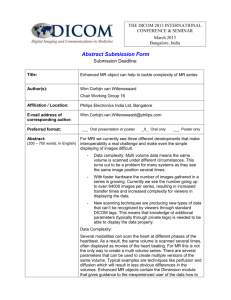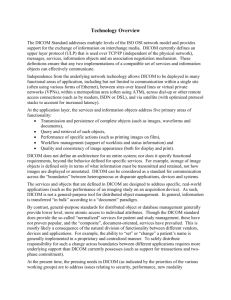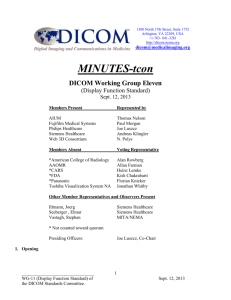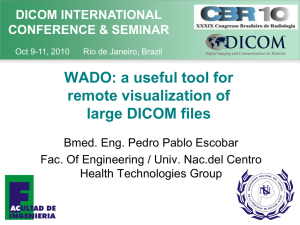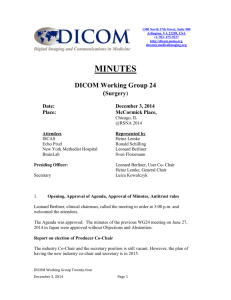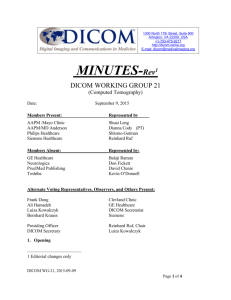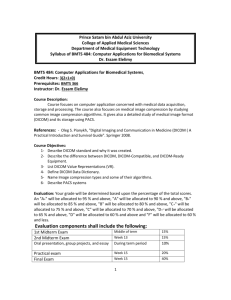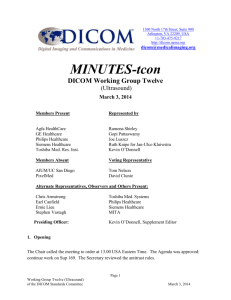9Oct_1435_Loef
advertisement
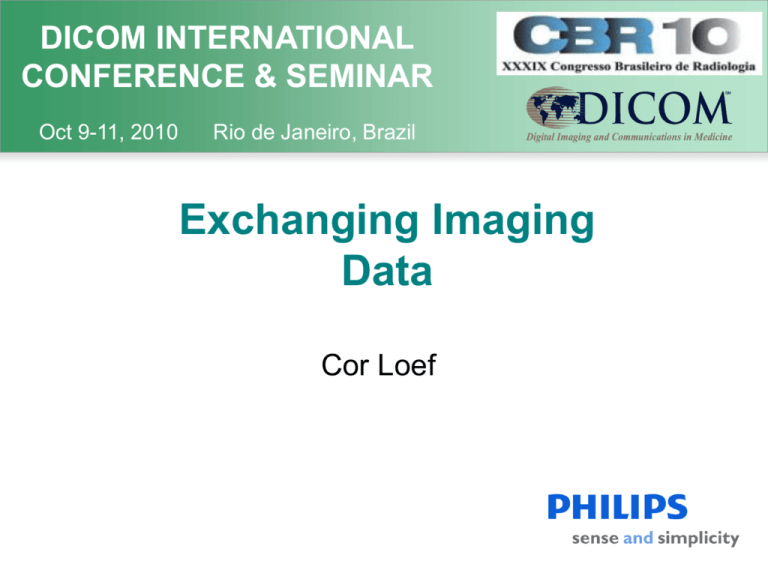
DICOM INTERNATIONAL CONFERENCE & SEMINAR Oct 9-11, 2010 Rio de Janeiro, Brazil Exchanging Imaging Data Cor Loef Exchanging Imaging Data • Objective: This presentation will answer the following question: – What are the types of DICOM objects and how do we move them around, i.e. over a network as well as on media? Exchanging Imaging Data • Agenda – Main Classes of Objects: Images, Presentation States, Structured Reports, Encapsulated Objects – Pushing Objects, Pulling Objects, Finding Objects and Retrieving Objects – DICOM as a Protocol vs a File Format vs a product Internal Data Representation – Use of Media (CDs, Memory Sticks, Email, WADO) Information Object Definition (IOD): IE’s Modules Attributes Information Object Definition (IOD): • DICOM Composite objects: For persistent, “permanent” objects using DIMSE-C commands (C-Store, C-Move, CFind…) Multiple IE’s: relate to DICOM Information Model (Patient-Study-Series-Image…) Cannot be changed or modified, if so, create a new object with new SOP Instance UID Multiframe objects: Vector • • • • Ultrasound Multiframe Nuclear medicine XA and RF New objects: MR, CT, PET, XA-XRF (new), X-Ray 3D, US 3D • VL and ophthalmology • Any future new objects: NM (new) Structured Reports: • Same structure as Images: – “main body” contains report and/or other information (measurements, etc.) instead of pixels – Same structure for header – Same study information – Modality is “SR” – Has a tree structure SR example (IHE simple report): Document Title (CONTAINER) HAS OBS CONTEXT Observation Context (See Figure 5.3-5) 1 1-n CONTAINS Section Heading (CONTAINER) HAS OBS CONTEXT 0-1 CONTAINS 0-n 1-n Image Reference (IMAGE) Report Text (TEXT) INFERRED FROM 0-n Image Reference (IMAGE) 0-n Measurement (NUM) 0-n Measurement (NUM) Observation Context (See Figure 5.3-5) SR example (Key Image/Object Note-KON): Document Title (CONTAINER) HAS OBS CONTEXT 1 CONTAINS 1 Key Image Description (TEXT) 1-n Image Reference (IMAGE) Observation Context (See figure 5.3-5) Encapsulated Objects (SC and PDF): • Some objects are difficult to encode as “native” objects: • Secondary Capture (SC): – Digitized film, captured video, documents • Encapsulated PDF: – typically for bone scans and eye care (topographic maps) Softcopy Presentation State: - Present images (almost) identical on softcopy media in standard manner - Separation of Stored Image Instances from Display characteristics and changes - Includes shutters, image annotation, spatial transformation, display annotation Softcopy Presentation State: Solution: - Create Composite object containing the presentation state parameters ONLY (no images) - Link this Composite object to one or more images (Series, Images); stored within same Study; Modality “PR” - Communicate with regular Storage service (C_Store); Retrieve with Query/Retrieve service How do we move these objects around? Push, Pulling Objects (Storage SOP Classes), Finding Objects (Information model/FIND) and Retrieving Objects (Move/Get) Storage Service class: Information System Modality Push/ PACS Push Printer DICOM C-Store Modality Archive PACS Viewing Storage Service class: Allow composite objects, e.g. images, reports, RT plans, waveforms, to be transferred from one to the other AE One AE functions as the SCU, the other one SCP The SOP classes use the C-Store DIMSE-C service The information is stored in some medium, accessible for some time (Issue! Might need Storage commitment!) Query/Retrieve Service class: Information System SCU/ SCP Modality Pull/PACS Pull Printer DICOM C-Find DICOM C-Move Archive Modality PACS Viewing Query/Retrieve Service class: Simple Query, NOT a full SQL: Query: Perform basic image information queries using small set of common key attributes (“FIND”) Retrieve: Either from remote AE (“GET”), or Xfer from one AE to the other (“MOVE”) Note: “GET” rarely supported Extended with retrieval of selected frames of a multi-frame Query/Retrieve Service class: Note: Most vendors also support a proprietary, direct protocol DICOM I/F SQL database (Informix, Sybase, Oracle) Query/Retrieve Service class: Key Attributes: U: Unique R: Required O: Optional Image IOD Pat name Pat ID ---------- Keys Keys for FIND: Patient’s Name (0010,0010) R Patient ID (0010,0020) U Study Date (0008,0020) R Study Time (0008,0030) R Accession Number (0008,0050) R Study ID (0020,0010) R Study Instance UID (0020,000D) U Modality (0008,0060) R Series Number (0020,0011) R Series Instance UID (0020,000E) U Instance Number (0020,0013) R SOP Instance UID (0008,0018) U Query/Retrieve Service class: Q/R SOP Classes use: C-Find: SCP performs a match of all the keys specified in the identifier of the request against the information it has, depending on level specified (Patient, Study, Series, Image) SCP provides Response for each match with values of all key fields and requested, known attributes Can also Cancel if needed Query/Retrieve Service class: Q/R SOP Classes use: C-Move: Upon providing unique key values by the SCU, the SCP initiates C-Store for the SOP instances indicated. SCP becomes SCU for Store; requires separate Association C-Move responses with status pending can be issued till all the C-Stores are completed or after each Store (see conf statement) Can also issue Cancel at any time Protocols, Files, Storage • Protocols: – DICOM is a communication standard defining the protocol (PDU, TCP/IP, addressing: port #, AE title) • Files: – DICOM ALSO defines a standard for exchanging files on media: encapsulated with “group 2” also known as Part-10 files – Media includes CD, DVD, flash media – The part-10 file format is extended for exchange using emails (WADO) DICOM Media: •Meta-file header: •Transfer syntax (encoding) •SOP Class •Who generated it •Compliant with standard OS’s •DICOMDIR is also required for exchange media Medical Information Application Application Entity Service Class Specifications Information Objects Definitions Data Set Structure and Encoding - Data Dictionary Message Exchange DICOM Upper Layer Service Boundary DICOM Upper Layer File Format DICOM Basic File Service Boundary Security Layer (Optional) Security Layer (Optional) TCP/IP Transport Layer Network Exchange On-Line Communication Physical Media and Media File Formats Media Storage Interchange Off-Line Communication DICOM Media Specifications: part 10 DICOM Application Entity Basic Dir. Service / Object Pairs part 12 part 11 DICOM File Format Media Formats: e.g. File data structures Physical Media: e.g. CD-R; 90 mm MOD, etc. Protocols, Files, Storage: • Storage: – DICOM does NOT define how to archive images (there is NO archive standard) – Some vendors preserve the images in a DICOM format, some pre-process the images using a compression method, either standard or proprietary – Migration of both PACS databases and archives are common when changing releases, vendors, etc. Conclusion: • DICOM objects include not only images but also SR’s, Presentation states, and encapsulated objects • DICOM images are moved around using the DICOM protocol, and exchanged using the DICOM part-10 file definition • There is NO DICOM archiving standard, some archives store natively, some do not DICOM INTERNATIONAL CONFERENCE & SEMINAR Oct 9-11, 2010 Rio de Janeiro, Brazil Thank you! Cor Loef: cor.loef@philips.com www.philips.com

![[#MIRTH-1930] Multiple DICOM messages sent from Mirth (eg 130](http://s3.studylib.net/store/data/007437345_1-6d312f9a12b0aaaddd697de2adda4531-300x300.png)
